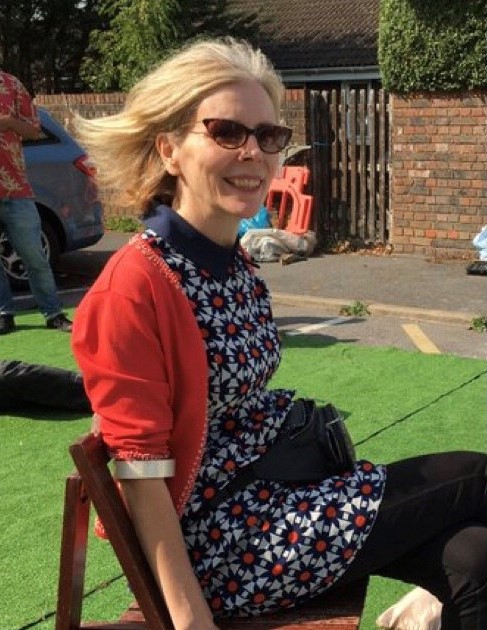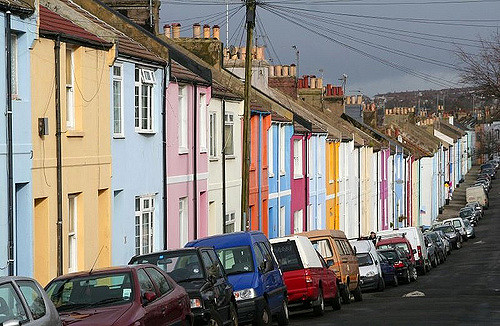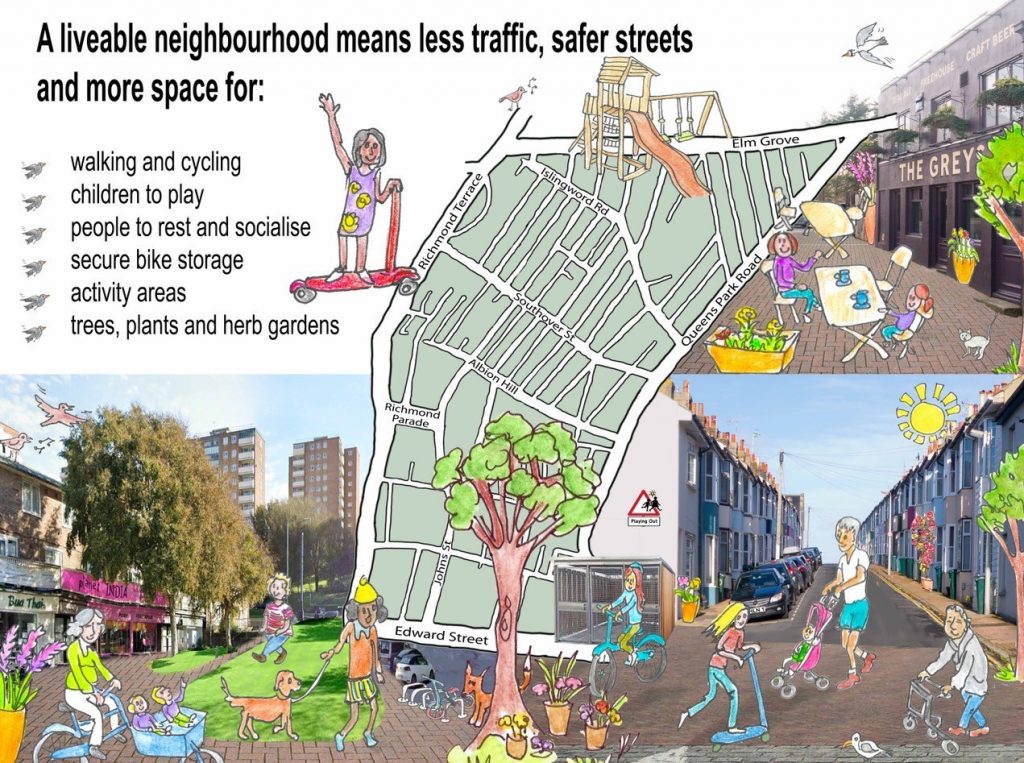The city’s first liveable neighbourhood pilot was given the go-ahead last June, following a request by local community group Hanover Action.
The group took its proposal to the council’s Environment, Transport and Sustainability Committee.
The main purpose of the scheme will be to stop outside traffic from cutting through our residential streets – and I’m working with residents to decide what this will actually look like.
It’s understandable that this issue has been raised. Last year a heavy goods vehicle caused extensive damage to a property on the corner of Southover Street.
A resident who lives further down the street recently told me van drivers have mounted the kerb, swung round the corner and hit her corner property several times. Understandably, she feels unsafe and wants something to be done.
Hanover Action saw a need to address a number of ongoing problems in the area. Hanover’s narrow streets, built in the 1860s, were not designed with traffic or parking in mind.
Residents often complain about the increasing volume and speed of traffic. While the 20-mph speed limit in the area is welcome, it is not always adhered to.
At the same time, narrow pavements mean those in mobility scooters and wheelchairs, blind or visually impaired residents and parents with buggies and small children often struggle to navigate safely. Social distancing can be impossible.
Towards the end of the first lockdown, I carried out a survey among the residents of the ward I represent, Hanover and Elm Grove.
Many said that they enjoyed the quieter streets that the reduction in traffic brought about. Others said that they’d bonded more with neighbours and other local people.
Introducing measures to stop drivers rat-running through our streets will help us to hold on to this new-found connectedness and tranquillity while enjoying more vibrant outdoor spaces.
The liveable neighbourhood scheme must be done hand in hand with local people. Residents know their own street’s niggles and needs more than anyone.
Liveable Hanover has created a web page where people can learn more and add ideas about what the scheme should include. We’ve written about it on our community website too.
Hanover Action’s Ian McIntyre has put posters up all over the area, outlining the scheme’s aims and inviting people to get involved.
We’ve invited people to events through social media, including the Liveable Hanover webinar I hosted last December, at which Clyde Loakes, from Waltham Forest Council, outlined how much the “mini-Holland” schemes there had improved the area and residents’ health.
Here in Hanover, we’ve recruited street contacts who have distributed leaflets and created WhatsApp groups to discuss their visions of a more liveable neighbourhood.
Many have taken part in the My Dream Street project, creating posters and displaying them in their windows.
Children from St Luke’s, Elm Grove and Carlton Hill schools have joined in too and an exhibition of their posters will take place at the Jubilee Library in September.
We want to put the wellbeing of the most vulnerable at the heart of our plans and create public space that considers the needs of all who live and work in the area.
One of the greatest payoffs of designing outdoor space with disabled and elderly people in mind is that everyone benefits, as an inclusive public realm promotes physical activity and health, through wider, safer pavements, public seating and more green spaces. And children gain the freedom to play outside and walk to school independently.
Meanwhile, the city must recover from covid by reshaping our communities to be more equitable to all, which means working to improve air quality to reduce people’s susceptibility to the worst effects of respiratory viruses and conditions.

The pilot will use “modal filters” such as large planters and bollards to reduce vehicle access and create strategic point closures.
This, along with the creation of more one-way systems, should discourage drivers from cutting through the area.
The safer and more pleasant environment that will come from less through-traffic will hopefully encourage drivers in good health who live within the scheme to swap shorter car trips to journeys on foot or by bike. Crucially, residents will still be able to drive and park.
The pilot will also be designed to ensure access to delivery, waste collection and emergency service vehicles.
Emergency vehicle response times should stay despite the need to navigate filters, as they make up time through the reduction in traffic.
But this will be closely monitored – and special filters that only allow only emergency vehicle access can be put in place, if needed.
Streets will be fully accessible to cargo bikes, which in London are being used increasingly to courier goods as they are often quicker than van deliveries.

We want to encourage companies to use cleaner delivery methods like this, which will further cut the level of motorised traffic in residential areas.
Hanover sorely lacks trees and green space, so these are also high on the liveable neighbourhood wish list. We hope to reclaim unused areas to create pocket parks using sustainable drainage techniques to channel rainfall into designated areas, thus allowing greenery to flourish.
Such spaces will give people opportunities to enjoy a quiet moment or chat to a neighbour, increasingly seen as important to mental health.
Parklets will be considered in the scheme too, roadside spaces with seating, planters and greenery. They give residents without a garden the opportunity to enjoy fresh air and can provide resting points for those with limited mobility.
Commercial parklets can provide pubs and cafes with permanent outdoor seating off the pavement. The Liveable Hanover group set up a pop-up parklet last September to give people a taste of what more social space in the area might be like.
The scope of the pilot was extended into the Tarner area, following discussions with transport planners about how to best deliver a workable scheme.

The council will soon be appointing consultants to look at how the scheme might best be delivered and Liveable Hanover will be dropping a leaflet through all letterboxes within the pilot area in May and June to give everyone the opportunity to learn more and share their views.
We hope to organise face-to-face events too, when covid restrictions end. All of this preliminary engagement will feed into a more formal council consultation, set to take place in late summer, and work could start by the end of the year.
As it’s a pilot scheme, filters will initially be temporary, as we need to make sure we get the scheme right. The changes will be monitored and tweaked if necessary and residents will be asked which changes they’d like to be made permanent in a final consultation.
We’ll then be able to inform sat nav providers of the changes and they’ll finally stop advising oversized lorries to cut though our streets.
If delivered well, the liveable neighbourhood scheme will transform the area, improve the lives of all who live and work here and provide a blueprint for similar schemes across the city.
Councillor Elaine Hills represents Hanover and Elm Grove on Brighton and Hove City Council.










Let’s be clear, this will not remove traffic overall. People still need to get from A to B. What it will do is displace traffic and reduce it within this area. These privileged streets will have less traffic, but that does mean that other streets will have more traffic. And, if these displacements mean more distance travelled, a higher level of traffic across the city overall
So yes, let’s explore some streets having less traffic. But that does mean others having more. The modelling of this traffic movement needs to be done along with a plan to measure the effects, including pollution, on the streets where traffic is moved to. Crucially these streets also need to have a say in the trial and should agree to the extra traffic
This may work for some areas but will make it worse for others – elm grove and QPR. We need to understand where the traffic comes from – much will be generated by local residents, + deliveries for local residents. This needs surveying and modelling. Planters? But each house has its own garden + we have Queens Park and the sea in walking distance. Cargo bikes? Try that up Southover St! And how would an Amazon driver cope delivering our purchases. Speed limits need to be enforced across brighton and this alone could contribute towards a better environment. This is a worthy project but is led by the greens and their own “community” action group. I hope they are willing to take into account and involve the views of ALL residents. From my experience they cannot cope with criticism.
The trouble is the poor planning and restrictions on the routes that we’d prefer traffic to use are also being deliberately restricted by this council, making it necessary for vehicles to cut through in the first place. If congestion was not being deliberately caused in B&H then traffic would be much lower and only caused by residents and deliveries. Sadly the misguided belief that changing two carriageways to one to allow a few bikes would improve air quality and encourage active travel is not yielding the results (although everyone except the current council can see it). Also arbitrary speed limit reductions across the board do not actually help road safety or pollution, on the latter it is know to increase it. A pragmatic approach of signage where there is actual need for caution (such as around schools etc) is much more effective than just making everywhere the same speed, at which point the message is lost…
This has the makings of disaster, with Hanover becoming a Green Ghetto with a huge knock on effect on areas close by such as Queens Park. Traffic does not simply disappear like the tooth fairy it ends up getting displaced – I worry for the neighbouring wards.
Well, the evidence is that a good proportion of traffic *does* disappear – look up traffic evaporation https://en.wikipedia.org/wiki/Induced_demand#Reduced_demand.
It’s the opposite of the well proven issue of “Induced demand” where a new road leads to more traffic, rather than the number of vehicles staying the same.
But I’m just one of those pesky professional transport planners, what do I know. Experts are so last century….
Traffic suppression, as it’s also known in the same Wikipedia entry, will often lead to displacement, all other factors being equal.
For recent evidence of this, you don’t need to be an expert. Just look at what happened after the Lewes Road changes. Coombe Road and Bevendean Road became much busier, as did Hartington Road, and Woodingdean became a semi-permanent traffic jam during daytime hours.
Congestion is now much worse over a wider area, along with the air pollution, which in Lewes Road, specifically, remains noxious.
The building of many more tower blocks of student flats in Lewes Road (and London Road soon) will of course intensify the canyon effect and worsen the air quality even more. And all this courtesy of a Green council. Hard to imagine a worse result if they were in reality the Pollution Party.
What we need is data. How much traffic is cutting through the area and how much is generated from within hanover. If it is mostly the latter I suspect it will.just make life more inconvenient for the locals. The greens like to cite the example of waltham forest but there is no comparison. Traffic in hanover is not an issue compared to London + wf is mostly flat (ideal to promote cycling) whilst hanover is up a hill side. LTNs can work but any solutions need to understand the local issues. Transport planner who has worked on these schemes in london.
Mark strong makes me laugh. I used to drive into Brighton from the suburbs, but now I drive to Holmbush or Crawley instead, and I make the occasional trip to the new shopping centre in Eastbourne. The parking is free at Holmbush, and cheaper in Crawley and Eastbourne than Brighton. I also made a few trips to Bluewater before the lockdowns started, where the parking is also free. Given the mess made of the Old Shoreham Road, Bluewater is looking like a more frequent destination for me as we all get back on the road again. The fuel bill for a Bluewater trip in my car is only marginally more for me and my partner than if we took the bus into Brighton. The reality is more and more people like me are choosing to drive further as Brighton becomes driven by impractical ideology. We haven’t evaporated. We just go a little bit further to where reality reigns and where we’re welcome.
Out of interest, what _would_ make you drive less?
Private transport offer direct, flexible, comfortable, rapid, safe, all weather, anytime, load carrying transport. With EVs (or offsetting) they are also zero-carbon.
Why would I want to drive less? :-[
Well, a total reduction still has to occur – we can’t all just offset. Additionally, it’s expensive and not a lot of people do it.
I can accept that people like their cars – but sticking to one you don’t absolutely need is extremely selfish.
In general this city has far too many cars. The air’s polluted, it stinks, the roads are dangerous (yes yes, congestion, but they were getting bad before the 20mph came in and drivers don’t seem to stick to rules if they dislike them). The incipient climate disaster won’t be solved here, but it’s important to do our part even so. The only solution is to become a much lower traffic city, and maybe gently encourage people like yourself and Verity to move to other areas more in keeping with your values. There’s nowhere like Brighton, but there are plenty of near-Right dystopia towns where “I’ve got mine” fits right in.